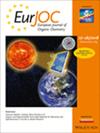[4 + 1]环化取代水杨基N -膦酰亚胺聚合诱导不对称合成2,3 -二氢苯并呋喃
IF 2.5
3区 化学
Q2 CHEMISTRY, ORGANIC
引用次数: 0
摘要
通过水杨基N -膦酰亚胺与硫酰化反应,实现了聚集诱导的反式2,3 -二氢苯并呋喃化合物的不对称合成。这种转化通过[4 + 1]环化途径进行,提供具有可调非对选择性的良好至优异产量的产品。通过将各种THF/EtOH共溶剂体系与基团辅助净化(GAP)化学相结合,传统的聚集共溶剂体系在增强非对异选择性和调节聚集形成方面发挥了关键作用。这得到了聚集诱导发射(AIE)、聚集诱导极化(AIP)和动态光散射(DLS)研究的支持。该方案为2,3 -二氢苯并呋喃支架的合成提供了一种实用且通用的方法,突出了聚集诱导不对称合成(AIAS)作为实现立体控制的有力策略的实用性。本文章由计算机程序翻译,如有差异,请以英文原文为准。
Aggregation‐Induced Asymmetric Synthesis of 2,3‐Dihydrobenzofurans by [4 + 1] Annulation with Substituted Salicyl N‐Phosphonyl Imines
The aggregation‐induced asymmetric synthesis of trans‐2,3‐dihydrobenzofuran compounds was achieved via the reaction of salicyl N‐phosphonyl imines with sulfur ylide. This transformation proceeds through a [4 + 1] annulation pathway, affording products in good to excellent yields with tunable diastereoselectivities. By employing various THF/EtOH cosolvent systems in conjunction with group‐assisted purification (GAP) chemistry, the conventional aggregation cosolvent systems were shown to play a crucial role in enhancing diastereoselectivity and modulating aggregate formation. This was supported by studies involving aggregation‐induced emission (AIE), aggregation‐induced polarization (AIP), and dynamic light scattering (DLS). The developed protocol provides a practical and versatile synthetic approach to 2,3‐dihydrobenzofuran scaffolds, highlighting the utility of aggregation‐induced asymmetric synthesis (AIAS) as a powerful strategy for achieving stereocontrol.
求助全文
通过发布文献求助,成功后即可免费获取论文全文。
去求助
来源期刊
CiteScore
5.40
自引率
3.60%
发文量
752
审稿时长
1 months
期刊介绍:
The European Journal of Organic Chemistry (2019 ISI Impact Factor 2.889) publishes Full Papers, Communications, and Minireviews from the entire spectrum of synthetic organic, bioorganic and physical-organic chemistry. It is published on behalf of Chemistry Europe, an association of 16 European chemical societies.
The following journals have been merged to form two leading journals, the European Journal of Organic Chemistry and the European Journal of Inorganic Chemistry:
Liebigs Annalen
Bulletin des Sociétés Chimiques Belges
Bulletin de la Société Chimique de France
Gazzetta Chimica Italiana
Recueil des Travaux Chimiques des Pays-Bas
Anales de Química
Chimika Chronika
Revista Portuguesa de Química
ACH—Models in Chemistry
Polish Journal of Chemistry.

 求助内容:
求助内容: 应助结果提醒方式:
应助结果提醒方式:


